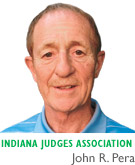Subscriber Benefit
As a subscriber you can listen to articles at work, in the car, or while you work out. Subscribe Now
 The Judicial Administration Committee of the Judicial Conference of Indiana began conducting research
The Judicial Administration Committee of the Judicial Conference of Indiana began conducting research
on jury reform in 1997. At approximately the same time, the Indiana Supreme Court organized citizens, attorneys, and judges
to form the Citizens Commission for the Future of Indiana Courts. The commission obtained grant funding to study the jury
system and formed the Juries for the 21st Century Committee to collect data and information on jury procedures.
The recommendations of both the Judicial Administration Committee and the Citizens Commission resulted in new jury rules
for Indiana effective Jan. 1, 2003, covering jury pool formation, selection, and management. The objectives of the new rules
were to promote consistency in jury procedures throughout the state, to improve efficiency within the jury system, to require
all qualified citizens to serve with few exceptions, to promote diversity in the jury pool and the trial jury, and to assist
jurors in understanding the issues, evidence, and trial process.
To help local courts implement these new rules, Chief Justice Randall T. Shepard established the Jury Committee of the Judicial
Conference of Indiana in 2002. The Jury Committee developed a standard orientation program for jurors pursuant to the new
rules and it continues to respond to questions from local courts and to recommend improvements to the jury system. In 2003,
the Jury Committee worked with a local production company to produce a standard jury orientation video entitled “Indiana
Jury Service: Duty, Honor, Privilege,” which is available to all Indiana courts at no cost and is also available to
the public on the Internet at http://www.in.gov/judiciary/juryduty/.
This video was updated in 2008.
The Jury Committee also worked in partnership with judicial and executive branch agencies on the state’s Jury Pool
Project, which provides to local courts a jury master list containing information from both the Bureau of Motor Vehicles and
state Department of Revenue. The first list was released in the fall of 2005, and the project team continues to improve the
list based on local court feedback. This new master list is more inclusive of Indiana’s citizens than ever before and
has decreased the amount of undeliverable mail sent to prospective jurors. In 2006, the Indiana Supreme Court received a Special
Merit Citation from the American Judicature Society and the Indiana Civil Liberties Union’s Sigmund Beck Award for this
project.
After these incredible improvements in the ways that citizens are called to be jurors and their management when they get
to the courthouse, the next logical step was to improve the information given to juries about the specifics of the trials
in which they participate – the jury instructions.
The responsibility for this falls under the purview of the Indiana Judges Association Instructions Committee. Beginning in
the fall of 2008, the Civil Instructions Committee – one Court of Appeals judge and 12 trial court judges from all over
the state comprise the committee – reviewed research about legal language and juror comprehension, learning that disorganized
and jargon-heavy instructions do an utterly inadequate job of informing jurors of what they are to do. I vividly recall having
spoken with a very intelligent, college-educated presiding juror in a civil case, who described the jury instructions as “convoluted”
and at times “incomprehensible.” Many others no doubt have had similar exchanges with those who serve on our juries.
It was apparent that the language of the law, common and comfortable for lawyers and judges, was not getting the job done
when the same language was used to communicate with lay persons upon whom we place the responsibility to fairly decide the
outcome of civil lawsuits.
The product of these efforts, spanning nearly two years of countless hours of work, is the forthcoming publication of the
new Indiana Model Civil Jury Instructions, written in plain English, to be published in the coming weeks by Lexis.
Plain English involves using the simplest, most straightforward way to express an idea to our juries to increase comprehension,
compliance, and satisfaction with the jury process.
With the help of Elizabeth Francis, PhD., a University of Nevada English professor and faculty member at the National Judicial
College in Reno, the committee focused on clearly identifying the parties, omitting unnecessary words, using active voice
and understandable vocabulary, keeping sentences short, and organizing ideas in a logical sequence. The committee attempted,
however, to maintain the use of irreducible words (such as “liable”) and to avoid false economy by fully explaining
important ideas, rather than giving them short shrift. Some new instructions use examples or illustrations to explain especially
difficult concepts.
The Indiana Model Civil Jury Instructions will be introduced to the judiciary at the Judicial Conference
of Indiana Annual Meeting in September. To introduce members of the bar to them, the Indiana Judges Association will sponsor
seven CLE-approved, three-hour seminars during October at Merrillville, South Bend, Fort Wayne, Evansville, Jeffersonville,
Plainfield, and Indianapolis. Each seminar will be presented by four Civil Instruction Committee members. We hope members
of the bar will take advantage of the seminars to learn about this important development in Indiana law. Online registration
begins Aug. 16 at https://ijc.wufoo.com/forms/say-what-seminars-2010/.•
__________
The Hon. John R. Pera is chief judge of the Lake Superior Court, a judge in the Civil Division,
chair the Civil Instructions Committee and secretary-treasurer of the Indiana Judges Association. The opinions expressed in
this column are those of the author.
Please enable JavaScript to view this content.
